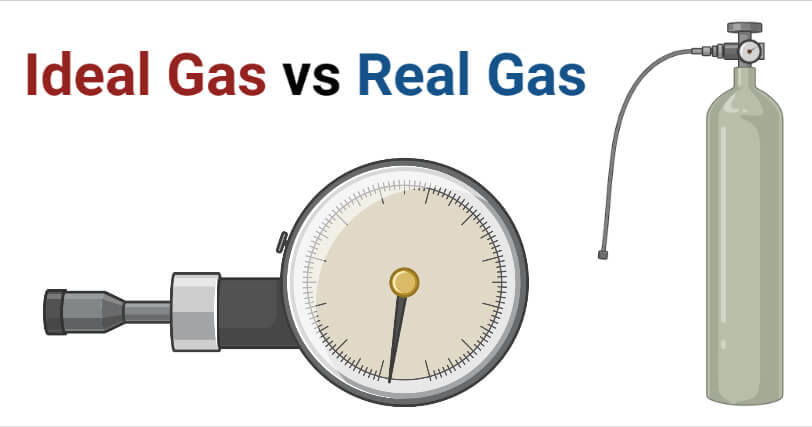Interesting Science Videos
Ideal Gas Definition
- An ideal gas is a theoretical gas that obeys the ideal gas law as the gas particles are not subject to interparticle interactions.
- The gas particles in an ideal gas are considered ideal particles as their interactions are perfectly elastic.
- The particles do not have definite volume and mass as the size of the molecules becomes less significant when compared to the empty space between the particles.
- Even though the ideal gas is a theoretical concept, some real gases might behave like ideal gas, usually at a higher temperature and low pressure. However, ideal gases might behave like real gases at a low temperature and high pressure.
- At high temperatures and low pressure, the potential energy of the gas due to the intermolecular forces is slightly less significant than the kinetic energy of the particles.
- Ideal gases obey the ideal gas law; PV=nRT where P, V, and T are pressure, volume, and temperature, n is the amount of substance and R is the ideal gas constant.
- The law was first described by Benoit Paul Emile Clapeyron as a combination of Boyle’s law, Charles law, and Avogadro’s law.
- Ideal gases can be further classified into three basic classes; classical ideal gas, ideal quantum Bose gas, and ideal quantum Fermi gas. Different classes of ideal gases can be defined by different means and parameters.
- As all the collisions in an ideal gas are perfectly elastic, there is no change in the kinetic energy of the particles after such collisions.

Real Gas Definition
- A real gas is a non-ideal gas that occupies space and doesn’t obey the ideal gas law as the gas particles tend to have interparticle interactions.
- Real gases do not obey the ideal gas as the collisions of the gas particles are not perfectly elastic.
- The particles of real gases have defined volume and mass as the sizes of the molecules have a definite mass as compared to the empty space in the structure.
- Real gases might become ideal gas at a higher temperature, and low pressure as the size of the molecules becomes insignificant. The properties of real gases become more prominent at low temperatures and high pressure.
- As the molecules have a defined mass, the particles have kinetic energy, which is higher than the potential energy of the gas.
- Real gases obey the real gas law; P+ a(n2/V2)(V-b)= nRT, where P, V, and T are pressure, volume, and temperature, n is the amount of substance.
- The behavior of real gases can be described based on various factors like compressibility factor, specific heat capacity, van der Waals force, and varying composition.
- The concept of real gases might be different in different models. However, it has been noted that the behavior of real gas is the same as that of an ideal gas as thus, the deviation of real gases from ideal behavior is unnecessary.
8 Key Differences (Ideal Gas vs Real Gas)
| Characteristics | Ideal Gas | Real Gas |
| Definition | An ideal gas is a theoretical gas that obeys the ideal gas law as the gas particles are not subject to interparticle interactions. | A real gas is a non-ideal gas that occupies space and doesn’t obey the ideal gas law as the gas particles tend to have interparticle interactions. |
| Ideal gas law | Ideal gases obey the ideal gas law. | Real gases do not obey the ideal gas law. |
| Intermolecular attraction | No intermolecular attractions exist between the molecules of the ideal gas. | There are intermolecular attractions between the molecules of real gas. |
| Volume and mass | The particles of ideal gas do not have a definite volume and mass. | The particles of real gas have a definite volume and mass. |
| Collisions | The collisions between the gas particles are perfectly elastic. | The collisions between the gas particles are not elastic. |
| Kinetic energy | The kinetic energy of the particles remains constant. | The kinetic energy of the particles changes with every collision. |
| Effect of temperature and pressure | An ideal gas might behave like a real gas at high pressure and low temperature. | A real gas might behave like an ideal gas at low pressure and high temperature. |
| Concept | An ideal gas is a theoretical concept. | All gases are real gases. |
References and Sources
- Gautum SD, Pant M and Adhikari NR (2016). Comprehensive Chemistry, Part 2. Sixth Edition. Heritage Publishers and Distributors Pvt. Ltd.
- https://pediaa.com/difference-between-real-and-ideal-gas/
- https://en.wikipedia.org/wiki/Ideal_gas – 29%
- https://www.omnicalculator.com/physics/ideal-gas-law – 7%
- https://byjus.com/chemistry/real-gas/ – 5%
- https://chem.libretexts.org/Bookshelves/General_Chemistry/Map%3A_A_Molecular_Approach_(Tro)/05%3A_Gases/5.10%3A_Real_Gases-_The_Effects_of_Size_and_Intermolecular_Forces – 5%
- https://quizlet.com/133483385/chemistry-13-1-flash-cards/ – 2%
- https://chemistry20gaslaws.weebly.com/gas-laws.html – 2%
- https://quizlet.com/84977694/chemistry-chapter-10-flash-cards/ – 1%
- https://www.vedantu.com/chemistry/deviation-from-ideal-gas-behaviour – 1%
